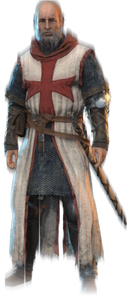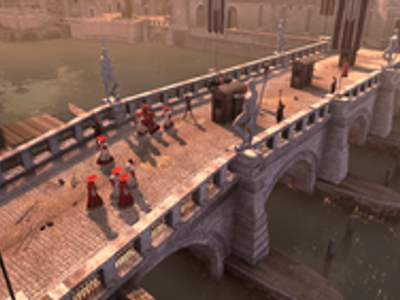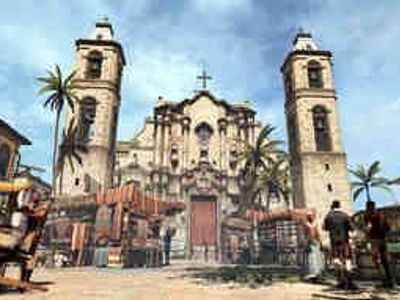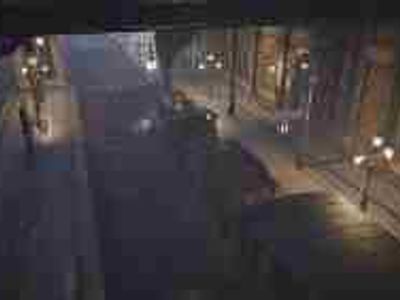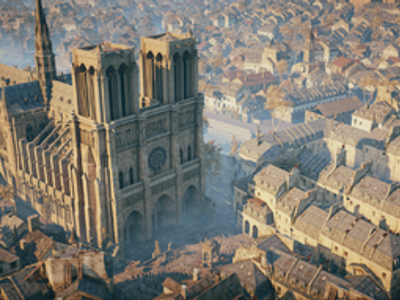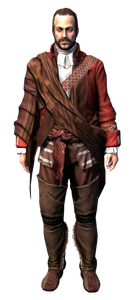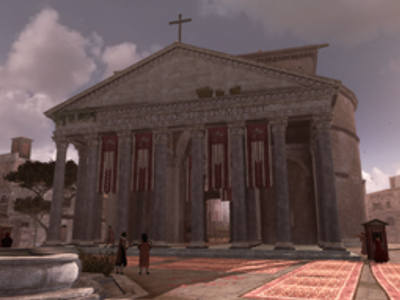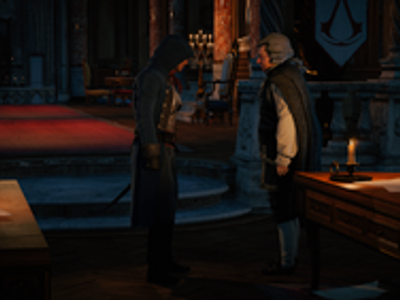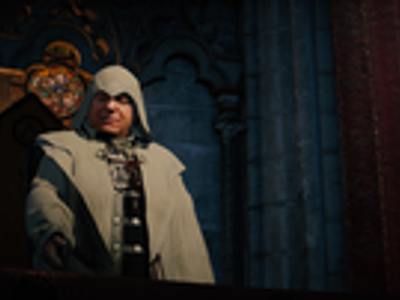
Character of the week - Jacques de Molay (AC Unity)
Jacques de Molay was born a Sage in 1244 in Molay, Haute-Saône. In 1265, de Molay was inducted into the Templar Order in Beaune. After the fall of Acre, the Order met in Cyprus in September 1291. On 20 April 1292, de Molay was elected Grand Master, leading the Templars to the height of their power. Around this time, he possessed the Shroud of Eden, which later wound up in the possession of a fellow French Templar, Geoffroy See More de Charny.
In 1305, Pope Clement V asked the leaders of various military orders for their opinions on a new crusade and the merging of the orders. While de Molay opposed a merge, King Philip IV of France favored it, specifically wishing to merge the orders into a force under his command.
At some point, de Molay wrote the Codex Pater Intellectus. With the Templars already serving as an economic power through banking, he envisioned in the Codex that the Templars should control humanity through the middle class and capitalism, rather than through the aristocracy and monarchy. Even as the Templars entered a Golden Age, Philip, strongly indebted to the Order, sought to disband it and claim its wealth. In the meantime, the Assassin Order had begun to weaken the Templars. Philip unknowningly served the Assassins through his advisor Guillaume de Nogaret, Mentor of their French branch.
On 13 of October 1307, raids were carried out across France with the intent of arresting all Templars. The Templar headquarters at the Temple were also raided by Assassins disguised as Flemish mercenaries, led by Esquieu de Floyrac and the Master Assassin Thomas de Carneillon. As the attack commenced, de Molay spoke with his advisor, and deduced that the Assassins were responsible. The advisor expressed his belief that the Brotherhood's power had been broken with the fall of Masyaf. De Molay told him that the Assassins were indeed not destroyed, and instructed the advisor to hide the Codex and the Templars' Sword of Eden, before leading his men in battle.
While the advisor was able to hide the Codex and Sword, de Molay was arrested, and the former was assassinated by de Carneillon before he could rescue the Grand Master. As a result of the raids, nearly every Templar in France was arrested. In 1312, the Templar Order was officially dissolved by Pope Clement in his papal bull, Vox in excelso, and all of its assets were gifted to the Knights Hospitalier.
On 18 March 1314, de Molay allowed himself to be burned at the stake alongside Geoffroi de Charney. As he burned to death, he cursed Philip to the "thirteenth generation of [his] blood". By allowing himself to be executed, de Molay saved the lives of his remaining brethren, and made their enemies believe that the Order had died along with him.
Jacques de Molay was born a Sage in 1244 in Molay, Haute-Saône. In 1265, de Molay was inducted into the Templar Order in Beaune. After the fall of Acre, the Order met in Cyprus in September 1291. On 20 April 1292, de Molay was elected Grand Master, leading the Templars to the height of their power. Around this time, he possessed the Shroud of Eden, which later wound up in the possession of a fellow French Templar, Geoffroy See More de Charny.
In 1305, Pope Clement V asked the leaders of various military orders for their opinions on a new crusade and the merging of the orders. While de Molay opposed a merge, King Philip IV of France favored it, specifically wishing to merge the orders into a force under his command.
At some point, de Molay wrote the Codex Pater Intellectus. With the Templars already serving as an economic power through banking, he envisioned in the Codex that the Templars should control humanity through the middle class and capitalism, rather than through the aristocracy and monarchy. Even as the Templars entered a Golden Age, Philip, strongly indebted to the Order, sought to disband it and claim its wealth. In the meantime, the Assassin Order had begun to weaken the Templars. Philip unknowningly served the Assassins through his advisor Guillaume de Nogaret, Mentor of their French branch.
On 13 of October 1307, raids were carried out across France with the intent of arresting all Templars. The Templar headquarters at the Temple were also raided by Assassins disguised as Flemish mercenaries, led by Esquieu de Floyrac and the Master Assassin Thomas de Carneillon. As the attack commenced, de Molay spoke with his advisor, and deduced that the Assassins were responsible. The advisor expressed his belief that the Brotherhood's power had been broken with the fall of Masyaf. De Molay told him that the Assassins were indeed not destroyed, and instructed the advisor to hide the Codex and the Templars' Sword of Eden, before leading his men in battle.
While the advisor was able to hide the Codex and Sword, de Molay was arrested, and the former was assassinated by de Carneillon before he could rescue the Grand Master. As a result of the raids, nearly every Templar in France was arrested. In 1312, the Templar Order was officially dissolved by Pope Clement in his papal bull, Vox in excelso, and all of its assets were gifted to the Knights Hospitalier.
On 18 March 1314, de Molay allowed himself to be burned at the stake alongside Geoffroi de Charney. As he burned to death, he cursed Philip to the "thirteenth generation of [his] blood". By allowing himself to be executed, de Molay saved the lives of his remaining brethren, and made their enemies believe that the Order had died along with him.
on January 22, 2016

Landmark trivia
The bridge was a restricted area in Brotherhood, except in certain memories, such as "The Ezio Auditore Affair".
The bridge was formerly known as Pons Aelius or Ponte Aelius.
The bridge was a restricted area in Brotherhood, except in certain memories, such as "The Ezio Auditore Affair".
The bridge was formerly known as Pons Aelius or Ponte Aelius.
on January 18, 2016

Landmark of the week - Ponte Sant'Angelo (ACB )
Ponte Sant'Angelo, or Bridge of the Holy Angel, is a landmark that connects the Vaticano district to the Centro district, and extends over the Tiber river in Rome.
The bridge was built to cross the river from the city center to Emperor Hadrian's mausoleum, which later became the Castel Sant'Angelo.
In 1450, its balustrades buckled due a surging mob of pilgrims making their way to the St. Peter's Basilica, leading to See More a mass drowning. Later, in the 16th century, the structure was used to display the bodies of executed men to the public.
Ponte Sant'Angelo, or Bridge of the Holy Angel, is a landmark that connects the Vaticano district to the Centro district, and extends over the Tiber river in Rome.
The bridge was built to cross the river from the city center to Emperor Hadrian's mausoleum, which later became the Castel Sant'Angelo.
In 1450, its balustrades buckled due a surging mob of pilgrims making their way to the St. Peter's Basilica, leading to See More a mass drowning. Later, in the 16th century, the structure was used to display the bodies of executed men to the public.
on January 18, 2016

Landmark trivia
Two Animus data fragments could be found atop the church.
Despite the structure not existing during Edward Kenway's time in Havana, the building was anachronistically included in Abstergo Entertainment's Virtual Experience due to its status as a recognizable landmark.
Two Animus data fragments could be found atop the church.
Despite the structure not existing during Edward Kenway's time in Havana, the building was anachronistically included in Abstergo Entertainment's Virtual Experience due to its status as a recognizable landmark.
on January 11, 2016

Landmark of the week - The Cathedral of Havana (AC4)
The Cathedral of Havana, referred to in full as La Catedral de la Virgen María de la Concepción Inmaculada de La Habana (English: Cathedral of The Virgin Mary of the Immaculate Conception), is a cathedral located in Havana, Cuba. It also serves as the seat of the Roman Catholic Archdiocese of San Cristobal de la Habana.
The Cathedral of Havana was built on the site of an earlier smaller church; construction began in See More 1748 and finished many years later, in 1777.
The cathedral was built in a Baroque style, featuring many curves and double curves that turn into column-like pilaster structures within the facade. As well as this, the building's obvious asymmetry and curious construction material - coral taken from the ocean nearby - make it one of the most unique houses of worship in the world.
In 1722, the pirate Edward Kenway visited the site whereupon the Cathedral would be built 26 years later, believing he would find his target, the Templar Grand Master Laureano de Torres y Ayala, there. Instead, he found Torres' bodyguard, El Tiburón, whom he followed to the Castillo de San Salvador de la Punta.
The Cathedral of Havana, referred to in full as La Catedral de la Virgen María de la Concepción Inmaculada de La Habana (English: Cathedral of The Virgin Mary of the Immaculate Conception), is a cathedral located in Havana, Cuba. It also serves as the seat of the Roman Catholic Archdiocese of San Cristobal de la Habana.
The Cathedral of Havana was built on the site of an earlier smaller church; construction began in See More 1748 and finished many years later, in 1777.
The cathedral was built in a Baroque style, featuring many curves and double curves that turn into column-like pilaster structures within the facade. As well as this, the building's obvious asymmetry and curious construction material - coral taken from the ocean nearby - make it one of the most unique houses of worship in the world.
In 1722, the pirate Edward Kenway visited the site whereupon the Cathedral would be built 26 years later, believing he would find his target, the Templar Grand Master Laureano de Torres y Ayala, there. Instead, he found Torres' bodyguard, El Tiburón, whom he followed to the Castillo de San Salvador de la Punta.
on January 11, 2016

Landmark of week - Waterloo station (ACS)
London Waterloo station is a major railway terminus in central London. Constructed in 1848, the station is located in the borough of Southwark, on the southern bank of the River Thames. It sits at the southern end of Waterloo and Westminster Bridge.
Pearl Attaway, a templar working for Crawford Starrick, was about to depart from the station with some new train engines when she was assassinated by Jacob Frye.
Waterloo is one of the 7 See More train stations in AC Syndicate. It is comprised of a central station and a secondary one, holding 6 lines in total.
London Waterloo station is a major railway terminus in central London. Constructed in 1848, the station is located in the borough of Southwark, on the southern bank of the River Thames. It sits at the southern end of Waterloo and Westminster Bridge.
Pearl Attaway, a templar working for Crawford Starrick, was about to depart from the station with some new train engines when she was assassinated by Jacob Frye.
Waterloo is one of the 7 See More train stations in AC Syndicate. It is comprised of a central station and a secondary one, holding 6 lines in total.
on December 14, 2015

Landmark trivia
A viewpoint was located on top of the north tower.
There is a seacret entrance to the cathedral from the sewers.
The Notre-Dame was single-handedly recreated for Assassin's Creed: Unity by Senior Level Artist Caroline Miousse, who spent more than two years on constructing the iconic monument. While most of the cathedral is faithful to the original, creative liberties had to be taken with most of the art that adorns it, which is protected under copyright law.
A viewpoint was located on top of the north tower.
There is a seacret entrance to the cathedral from the sewers.
The Notre-Dame was single-handedly recreated for Assassin's Creed: Unity by Senior Level Artist Caroline Miousse, who spent more than two years on constructing the iconic monument. While most of the cathedral is faithful to the original, creative liberties had to be taken with most of the art that adorns it, which is protected under copyright law.
on December 07, 2015

Landmark of the week - Notre-Dame de Paris
Notre-Dame, or the Notre-Dame Cathedral (French: Notre-Dame de Paris), is a famous Gothic-style cathedral in Paris, France. The structure was heavily desecrated and burgled during the tumultuous French Revolution.
Shortly after escaping from the Bastille, the french assassin Arno Victor Dorian infiltrated the cathedral and killed the templar Charles Gabriel Sivert by the confessionals.
Notre-Dame, or the Notre-Dame Cathedral (French: Notre-Dame de Paris), is a famous Gothic-style cathedral in Paris, France. The structure was heavily desecrated and burgled during the tumultuous French Revolution.
Shortly after escaping from the Bastille, the french assassin Arno Victor Dorian infiltrated the cathedral and killed the templar Charles Gabriel Sivert by the confessionals.
on December 07, 2015

Character of the week - William Johnson
Sir William Johnson, 1st Baronet (c. 1715 – 1774) was an Anglo-Irish official of the British Empire and a member of the Templar Order. During the Seven Years' War, Johnson commanded Iroquois and colonial militia forces. Johnson also assisted in keeping Native Americans committed to the interests of the British.
Born to Catholic parents, Johnson learned at a young age that his opportunities were limited. After converting to Protestantism See More sometime in 1738, he left his birth country of Ireland to live in British Colonial America with his uncle, Admiral Peter Warren. He left however, to live on his own, after he was unable to convince his uncle to build on the trading routes with the Kanien'kehá:ka, which would boost business ventures and profits.
With what money he had obtained, Johnson bought a plot of land, built a mill, house, store, and farm on a major point in the trade route, calling the area Mount Johnson. From humble beginnings, his placement along the Mohawk River quickly made him wealthy and among the nobles of the Colonies. In 1743 he moved once more, and obtained a much larger parcel of land, which he named Fort Johnson. During the interval time, he developed close relations with the Kanien'kehá:ka, learning their language and became familiar with their culture and customs.
Sometime before 1748, Johnson was brought into the Templar Order by Lawrence Washington. In 1752, Thomas Hickey was assigned as Johnson's assistant and followed him into the Order.In July 1754, Johnson was one of the many in attendance at the Albany Congress, where he was observed by the Assassin Shay Cormac. As Benjamin Franklin spoke outside the city hall, Johnson approached Franklin and discussed the likelihood of British Parliament granting autonomy to the colonies.
As a member of the Templars, Johnson was in charge of managing the land and property acquired by the Order's Colonial Rite. During a meeting with several clan leaders, Johnson was assassinated by the Assassin Ratonhnhaké:ton.
Sir William Johnson, 1st Baronet (c. 1715 – 1774) was an Anglo-Irish official of the British Empire and a member of the Templar Order. During the Seven Years' War, Johnson commanded Iroquois and colonial militia forces. Johnson also assisted in keeping Native Americans committed to the interests of the British.
Born to Catholic parents, Johnson learned at a young age that his opportunities were limited. After converting to Protestantism See More sometime in 1738, he left his birth country of Ireland to live in British Colonial America with his uncle, Admiral Peter Warren. He left however, to live on his own, after he was unable to convince his uncle to build on the trading routes with the Kanien'kehá:ka, which would boost business ventures and profits.
With what money he had obtained, Johnson bought a plot of land, built a mill, house, store, and farm on a major point in the trade route, calling the area Mount Johnson. From humble beginnings, his placement along the Mohawk River quickly made him wealthy and among the nobles of the Colonies. In 1743 he moved once more, and obtained a much larger parcel of land, which he named Fort Johnson. During the interval time, he developed close relations with the Kanien'kehá:ka, learning their language and became familiar with their culture and customs.
Sometime before 1748, Johnson was brought into the Templar Order by Lawrence Washington. In 1752, Thomas Hickey was assigned as Johnson's assistant and followed him into the Order.In July 1754, Johnson was one of the many in attendance at the Albany Congress, where he was observed by the Assassin Shay Cormac. As Benjamin Franklin spoke outside the city hall, Johnson approached Franklin and discussed the likelihood of British Parliament granting autonomy to the colonies.
As a member of the Templars, Johnson was in charge of managing the land and property acquired by the Order's Colonial Rite. During a meeting with several clan leaders, Johnson was assassinated by the Assassin Ratonhnhaké:ton.
on December 04, 2015

Landmark trivia
Pantheon is derived from Greek term Pantheion (hieron), meaning "(Temple) of All the Gods."
The Pantheon played a part in the simulated location of Rome for the first and second stage of the Animi Training Program, although Abstergo recruits could not go inside its interior or climb to the Pantheon's rooftop.
Whether it was day or night in Brotherhood, there was always a column of light shining down from the Pantheon's oculus.
Upon entering the Pantheon, the See More echoing voice of the herald behind the building could be heard.
Pantheon is derived from Greek term Pantheion (hieron), meaning "(Temple) of All the Gods."
The Pantheon played a part in the simulated location of Rome for the first and second stage of the Animi Training Program, although Abstergo recruits could not go inside its interior or climb to the Pantheon's rooftop.
Whether it was day or night in Brotherhood, there was always a column of light shining down from the Pantheon's oculus.
Upon entering the Pantheon, the See More echoing voice of the herald behind the building could be heard.
on December 02, 2015

Landmark of the week - Pantheon (AC B )
The original Pantheon was built in 31 BCE by Marcus Agrippa, after the Battle of Actium. In 126 CE, it was restored to its current form by the Emperor Hadrian, however, it retained Agrippa's original inscription and dedication. The inscription reads "M·AGRIPPA·L·F·COS·TERTIVM·FECIT" which translates to: "Marcus Agrippa, son of Lucius, in his third consulate, made this."
Originally, the Pantheon was used to commemorate the Roman gods and See More goddesses, but it was converted into a church by Pope Boniface IV in 609. Both the name and style of the building have inspired similar churches in Europe, most notably a second Pantheon in Paris, France.
During the Renaissance, the Assassin Ezio Auditore da Firenze climbed the rear of the building and entered through the landmark's oculus to assassinate a guard captain named Luigi Torcelli. This allowed him to disguise himself in the guard's uniform, before he set off to find "the Banker."
Also, during his time in Rome, Ezio purchased the Pantheon as a landmark.
The original Pantheon was built in 31 BCE by Marcus Agrippa, after the Battle of Actium. In 126 CE, it was restored to its current form by the Emperor Hadrian, however, it retained Agrippa's original inscription and dedication. The inscription reads "M·AGRIPPA·L·F·COS·TERTIVM·FECIT" which translates to: "Marcus Agrippa, son of Lucius, in his third consulate, made this."
Originally, the Pantheon was used to commemorate the Roman gods and See More goddesses, but it was converted into a church by Pope Boniface IV in 609. Both the name and style of the building have inspired similar churches in Europe, most notably a second Pantheon in Paris, France.
During the Renaissance, the Assassin Ezio Auditore da Firenze climbed the rear of the building and entered through the landmark's oculus to assassinate a guard captain named Luigi Torcelli. This allowed him to disguise himself in the guard's uniform, before he set off to find "the Banker."
Also, during his time in Rome, Ezio purchased the Pantheon as a landmark.
on December 02, 2015

